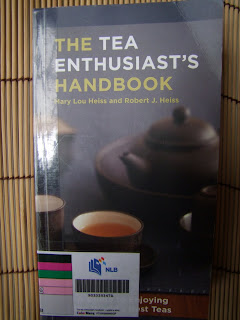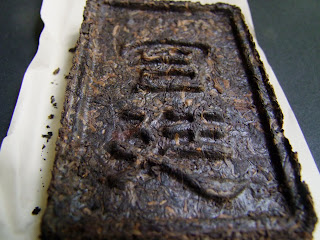
This very interesting article is from Cnngo by Virginia Lau entitled “12 things about tea your local dim sum restaurateur won’t tell you” (dated 7 Oct 2010). The writer interviewed Master Leung Ka-Dong who had been working at Ying Kee Tea House for almost 40 Years.
"What type of tea do you usually order when you eat dim sum?" asks Ying Kee Tea House Master Leung Ka-Dong (梁家棟).
"I usually order white hair peony because my family always orders it," I reply.
"Did you know that almost all restaurants mix their white teas with black to to add flavor and color?" he says.
No, I did not know that. I did not know that it's only in the recent 50 to 60 years that white, green and pu-erh have become Hong Kong's most popular teas either.
With a richer economy, Hong Kong people stirred away from simple black teas from India and Sri Lanka and began to enjoy tea for various health reasons or collect pu-erh tea like wine.
Thanks to Master Leung, who has worked at Ying Kee Tea House since the early 1970s, I now know a little more about how to appreciate Chinese tea.
Here are 12 things he told me about tea that no restaurateur would have:
1. Never drink tea on an empty stomach
Always drink tea during or after a meal. Our stomachs are acidic and tea is alkalizing.
Acid and alkaline combined have a bloating effect.
2. Drink white tea if you are a smoker
White tea is really good for the lungs and throat, so it is especially beneficial for smokers.
A cup of white peony tea helps clear all the phlegm in our throats and cures coughs.
3. You won’t be able to tell the quality of white tea by its color
Most restaurants mix white peony tea with black tea to add color and flavor because customers generally prefer tea that tastes richer and looks darker in color.
Pure white tea itself has hardly any flavor or color compared to other teas.
4. Only fine dining Chinese restaurants serve screw shaped green tea
Genuine screw shaped green tea is the highest grade of green tea and the most expensive. At Ying Kee Tea House, it sells at HK$5,067 per kilogram (HK$380 per 75 gram bag). Produced only in Jiangsu Province’s Dong Ting Mountain, it’s also the rarest green tea in China, producing only about 1,000 kilograms a year.
It must be consumed fresh, within a year after picking the tea leaves. Screw shaped green tea of higher quality is best consumed within six months even. If it is tasteless, solvent or extremely bitter, that means it has already gone bad.
But while it is certainly expensive, screw shaped green tea has a very particular taste that not everyone may like. Even when it is fresh, it tastes more bitter than other teas.
For all those reasons, screw shaped green tea is only served at fine dining Chinese restaurants, usually at hotels.
5. Treat pu-erh tea like a digestible detergent to flush all the grease away
Always pair oily food with pu-erh tea. Dim sum, no matter steamed or fried, contains lard. When you eat shrimp dumplings, there is always a piece of fatty pork in there to add flavor and fragrance.
Pu-erh tea helps you rinse all the grease from the food out of your system. It aids digestion, blood circulation and lowers cholesterol levels.
If you don’t have detergent at home, boil some pu-erh tea and use it to wash your dishes. It’s like a digestible detergent.
6. Sweets go best with green tea
Sweet food is best paired with tea that is more bitter. Loong cheng green tea helps moderate the sweetness of desserts.
Like pu-erh tea, drinking green tea helps lower cholesterol levels and break down fat.
But while most teas are best brewed in boiling hot water, green teas like screw shaped green tea and loong cheng only need to be brewed in water that is about 75 to 85 degrees. If the water is too hot, it will be difficult to maintain the same fragrance in the second brew.
7. Teh kuan yin goes best with spicy food
Spicy foods are best paired with teh kuan yin because it has a bittersweet effect. If you ever visit a Chiu Chow restaurant, they always serve teh kuan yin tea with their spicy dishes.
Plus, Chiu Chow city borders Shantou city and Fujian province, which is known for harvesting teh kuan yin leaves.
8. Fried food goes best with white tea
Basically, any type of fried or deep fried food goes well with white tea. In Chinese medicinal terms, fried food is considered “dry hot.”
White teas like white hair peony help release body heat.
9. Smell quality
Aside from pu-erh tea which is almost odorless, quality tea should always give off a fragrant smell.
If you can’t smell the tea or or see that it is very solvent, then it has probably expired.
10. You won’t be able to find good pu-erh tea at dim sum restaurants
It is simply not cost-efficient. Pu-erh tea is like wine. The longer you store it, the richer it becomes. Storage for at least three to six years is optimal.
Regular pu-erh teas served at restaurants have generally been modified during the fermentation process to reduce storage time. By doing this, they lose whatever fragrance and flavor they originally had.
Good pu-erh tea should look very smooth and deep red in color, not black like regular pu-erh tea.
You can also test the quality of your pu-erh tea by the stain it leaves on your cup after drinking it. If you see a stain surrounding the rim of your cup, that means you are drinking regular or low quality pu-erh tea. If your cup is left with no stain after consumption, you are drinking pu-erh tea of high quality.
11. Teh kuan yin, daffodil and oolong are all the same at dim sum restaurants
No matter which of the three you order, dim sum restaurants will serve you low grade daffodil tea. All three teas come under the same oolong tea category, yet they are very different in flavor.
Teh kuan yin tastes more clear and fragrant. Oolong is stronger and more solvent. And daffodil is the purest of them all.
12. The best moments of tea enjoyment are when you have time
Drinking tea is a matter of mood. And when I talk about mood, it mainly has to do with the condition of time.
You’ve probably heard many rules about tea, from water temperature to color. But at the end of the day, drinking tea is a very personal experience.
Some people like their tea boiling hot while others like theirs lukewarm. Some may like theirs stronger than others. So it’s all about time. We need time to brew that perfect cup of tea.









































